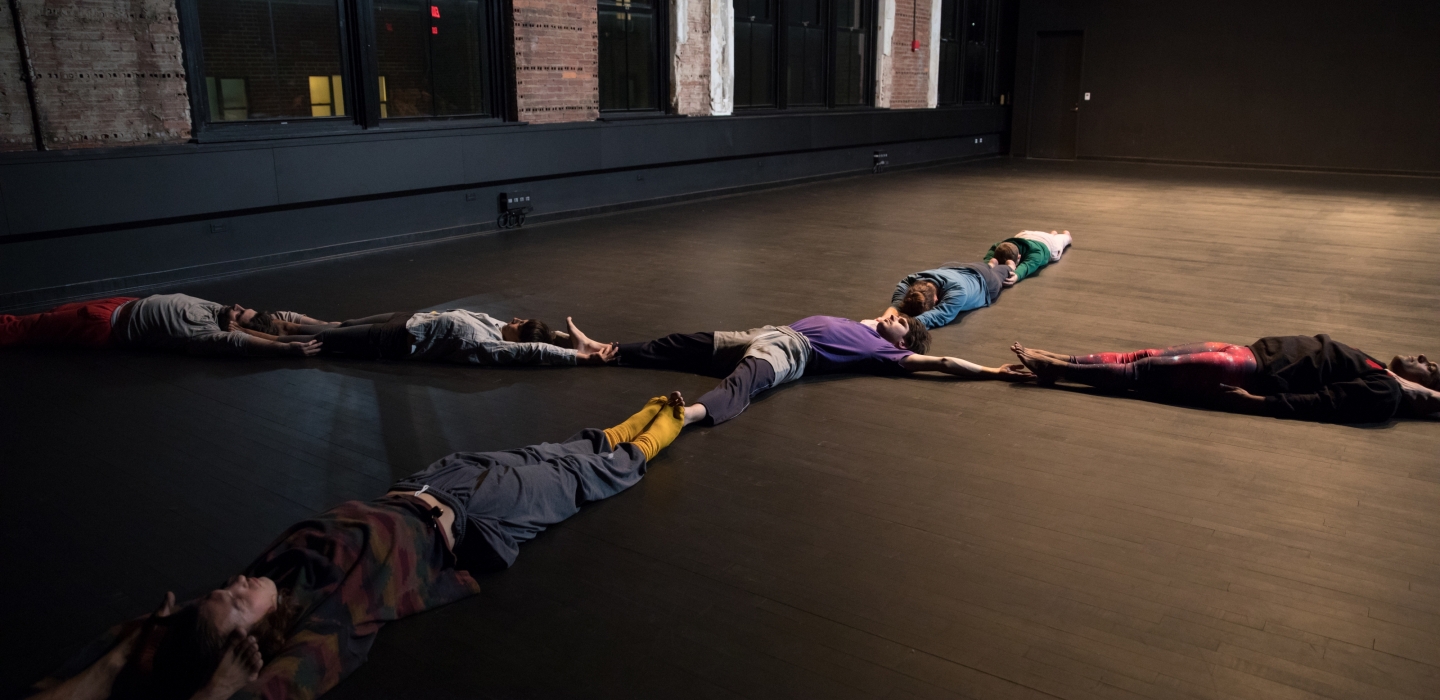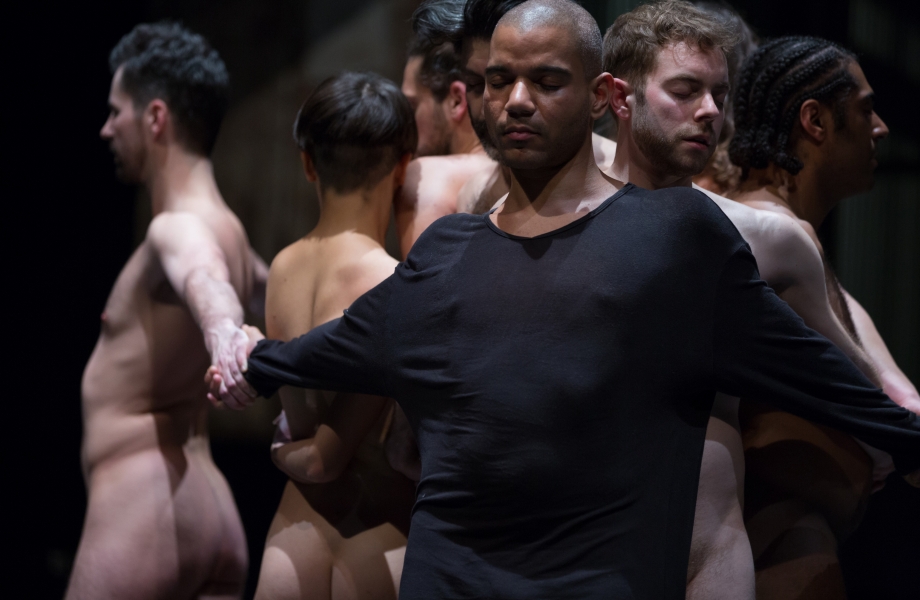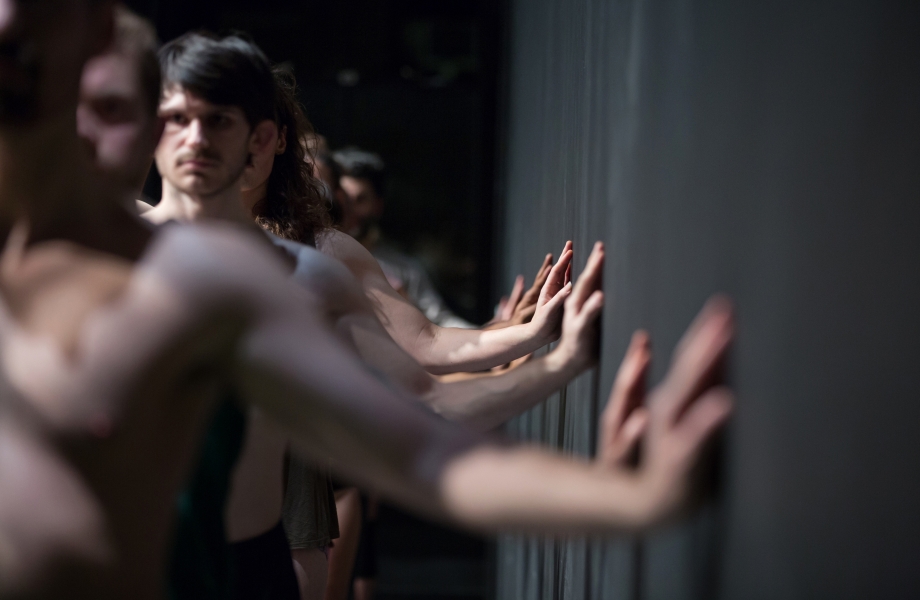visions of beauty: a dancer’s notes

arrive. hold. i'm here.
the dance is composed of seven practices:
COIL
PONY
CORNER
BALLET BAR
X
SWITCHBACKS
DD BOOMENGUY
you're always with yourself, with the practice, with each other.
beloved heather, you wrote me about solid objects, and it got me thinking about solidity, how important it is; the difference between strength and force, and how something solid might not mean hard and fixed but rather strong and rooted. i was thinking that fixing might make something weaker. then i thought of politics and the rotation system of certain indigenous political systems in south america. in the Andes, like in the central region of Abya Yala—or what we now know as america—certain communities have one-year rotation systems, to avoid abuse of power on the one hand, but also to force people to be responsible for their own communities, to learn how to be strong and defend their territories. everyone ends up having to do all the ‘roles’ throughout their lives. does non-fixity give more solidity? i had to think of COIL and switchbacks, because i am obsessive and i care so much about dance and details in dance—in such a way that even if we are over with the piece (and it was an amazing set of performances, such luxury to work with you and the whole team) i am still obsessively thinking about details and how to keep working on the dance. your choreographic works, and the way we are in them, mean a lot to me politically. even if no one ever cares about dance any more, or obsessive choreography, or that work in particular, or a particular move that was incarnated.
i am saying all this because i could just send you a mail saying i love you and it was amazing. but i had all these thoughts/feelings that are meaningful and incorporated, and they keep on mobilizing me.
… to continue…i was thinking of how beautiful COIL is, but there was a little something that was bothering me, and it was that we started to fix the places in the line we were in. two or three of us (dancers) were left with three or two options by the end, which meant to me at the time that COIL started to get a particular habit and was losing its experimentation, or that every-moment-negotiation with the floor, the hands, the space, the penises, the butts…well i am still very much negotiating, but mostly with my own frustrations and the observation of patterns/habits that start to get fixed and naturalized. whereas if i am not an organization fixed from the outside i am rather negotiating with my perception of the moment, at the absolute risk of failure but also of understanding COIL better through doing; the non-fixity brings me more into my own responsibility with the inside rather than negotiating my frustration of being judgy with the outside. perhaps what disturbs me profoundly is the naturalization of a particular order without question…on the other hand one could say that constantly moving or changing is also a way of fixing, you fix that you always move…so maybe the problem was me, that i fixed that i had to always move.
a sensual materialism. i think of virtuosity and refinement. i think of the studio practice as that absurd space, where some of us dancers of this particular dance tradition, we spend hours working on sophistication of movement. estilo danza tradicional. a la heather kravas. COIL to me is that absolute work. we work on grounding, how the feet touch the floor, and the floor (with all the histories of all the feet that touched it, and the history of the wood that forms it, the paint, the pain, and by addition, joy, that covers it, in the territory where it is built) touches us back. how the hands touch, move, and remain strong, but absolutely not fixed. how one feels a line with other bodies— how bodies, varied ones, are inhabiting forming and being formed by one line. air, the space in your front, your back, the lights. sensing. how do we get in and out of touch with each other and the matters of the world? how do we stay in touch with each other and the matters of the world? how do we let go of each other after having stayed in touch with each other?

and then there is the counter direction: to think that the coiling that folds toward the audience actually is coiling into itself, counter to the direction of the audience. sometimes you have to think and do the counter direction, go opposite of where you want to go in order to get there. the paradoxes of choreography.
attending to your own body and attending to other people’s bodies. how do we keep the fire burning?
in rehearsal Grace Jones’ “slave to the rhythm” chorus kept coming to my mind…what if we're serving the rhythm? if we think of serving in the most positive sense, as i think i heard Tonika Sealy Thompson say once, not in the form of slavery and subjugation, but as a form of love and care (my apologies to her if these are not her words). if we care for the rhythm, attend to the rhythm, cultivate the rhythm. in your words (heather kravas), tending to movement like tending to a fire. PONY. what are we working on and who cares? why get obsessed with a particular rhythm? who cares? what if we let the rhythm just be what it wants to be? but then…are we not actually following someone? does a leader not appear, perhaps even against its own will? if we are dance professionals, can we not work daily on attending the rhythm and serving the rhythm? or rather can we work daily and consistently on attending the rhythm and serving the rhythm? when do we stop working on it, and letting it be? is that the moment when we are following a rhythm like a herd? do we work on the rhythm until the premiere? do we work on the rhythm until the last day of performance? are we still working on the rhythm? are we doing or are we working? are we delivering or are we perfecting? understanding that perfection is not a possibility, but perhaps thinking that in the attempt to reach perfection, rather than having fascist aspirations, we are in fact getting lost in each other. the aspiration of perfection not with the aim of reaching machine-like precision but rather as a way of making something with each other second by second, to the point of doubting the boundaries of the container that holds your being. the more precise we are as a group in our intention the more i feel the strange feeling of getting lost and even doubting my own capacities, in a very exciting way. i wonder each time: who is it? is it me? am i making it faster? am i slowing it down? am i keeping the dynamics? am i holding it? am i making the rhythm even? it's a self doubt that is absolutely fruitful. if the working is not happening i feel my options are: 1) i have to forget what i think i should be doing and follow whatever supposedly the group is doing (or the group led by the strongest personality); or 2) i become forceful and try to impose what i think is right.
the option of following the uncritical mass is a very dangerous one for me. the option of being a hard-headed taurus makes me mad at myself. therefore i like the option of constantly working and problematizing and sharing experiences most, because it’s there that i realize how crazy different our bodies can be while trying to do the same.
and then there's the ballerina i’ve never been, but lives inside of me, for whom it is extremely important to follow the choreographer. to serve the rhythm, to serve the choreographer. by no means do i feel this to be negative. so if you, as the choreographer, say “that's the rhythm i want,” i want to do that rhythm and if you tell us “let go cos i don't care” then i also let go, and then i trust that both dancerly-wise within each practice and on a structural level: that is what the work needs. all is possible. it is permitted. it is allowed. and if it doesn't work, it is thrown out. so how much do we commit to serving the rhythm? or do whatever we want to do and see if we can get away with it as individuals or as a group?
arrive. hold! i'm here.
why is it that dancers in our field have a tendency towards in-betweenness and evening-out? why do we lose the dynamic? is it a form of comfort? a way of inhabiting the world? i don't feel in-between is a position of assertive interdependence, a conscious desire to be with others. arrival and fullness are a strong form of entanglement, an-other form of being inextricably linked even if the differences are incommensurable.
attending to your own body and attending to other people’s bodies. how do we keep the fire burning?
the right timing to leave CORNER ♥︎ ♥︎ ♥︎
♥︎
♥︎
♥︎
the choreographer drops a pen during BALLET BAR to indicate a new section.
open the curtains, close the curtains. the guests are coming.

articulation of rhythm. articulation of body.
what are the possibilities inside of a simple move such as SWITCH BACKS? simple physical possibilities that might end in affective possibilities, other-entity possibilities, other-world(s) possibilities, other-body possibilities. what is up with the homolateral movements? what feels so good about them? do they feel good in the body, or does it feel good to imagine how they look? is it against our will that our shoulders just open with the same side leg and the arm follows as if thrown? it can be homolateral, but does it have to be homolateral always? what are the possibilities? can we explore the possibilities? can we make it more layered, richer, firmer, and less graspable? can it be fuller, more delicious, meaty, otherly, grounded? can we be full without being consumed? can it shine in absolute allness in the moment without knowing what it is or might be or might become?
which takes me to what i've been thinking about related to the ego, objectification, and consumption. the individualist ego shows itself in a fixed position: a consumable position. it's a delicate matter, because all this compartmentalizing and creation of fixed identities comes with modernity and colonialism. the classification of others comes hand-in-hand with the abstraction of the european colonizer. while the colonized are classified in infinite boxes the european colonizer remains “neutral, abstract, objective, reasonable.” it studies and classifies the other from a pretended 0 position to which the anthropological gaze cannot be returned. the celebration of the identity of the subaltern is paradoxical in that it is both a resistance to its genocide and a reassertion of the colonial regime. while the whites remain with the privilege of not being fixed and boxed. as a “third-world” mestiza (clarification: that’s how the colony would categorize me, not me, but i lack a word for this context, understanding that mestizaje was a reactualization of the colonial genocide) from the south, with a majority of european ancestry, having been raised in an urban environment in the system of public education, daughter of professional parents, i am weary of my own position. what does it mean when i am in europe and i say i am a self-identified woman, however gender non-conforming, a latina from the very most southern part of the world (Wallmapu), struggling to live an anti-colonial life? does that give me legitimacy to speak about oppression, because i belong to the subaltern colonized people? or does it put me in a condition of inferiority with my colleagues, whom i consider equal (even if they don’t), with equal capacities to question the manners in which colonialism intersects and forms all of our lives? and most importantly what are my responsibilities and how am i accountable?
back to dance…to objectify is to be able to consume. if you are fixed you are more easily consumed. i understand that some people, because of the capitalist society we live in and its parameters of success, they want and love to be consumed. so the question for those of us, those that have been invisibilized in a smaller or greater degree: how can the invisibilized be visible and escape consumption? and now i'll be an academica trucha and bring in Édouard Glissant's “right to opacity,” which i don't want to claim i fully understand and i much less want to explain, but i thought i’d just put it in there.
to me there are two things:
to consent not to be a single being. not to always be the homolateral being. to surprise yourself in what being you can be. to allow yourself to be touched by others while allowing that touch to change you even if momentarily. to invite and embrace the multiplicities that we are or can be.
to consent to not be an individual. to consent to erase myself. to erase oneself into the collective is not to reduce oneself to dead matter or an object, but rather fluid matter. to resist being consumed, while assuming in every stage the fullness of what that fullness is, or what we are. that also means being responsible and accountable for what that is and what we are at each stage. a fullness without distance.
i keep thinking of devotion and subordination. solemnity and integrity. not avoidance but immersion. Moten speaks for “not aggrandizement but absolute humility.”
DD BOOMENGUY is cosmic and ancestral
i think that's all for today
X
adapted from an email to heather kravas from cecilia lisa eliceche, sent on february 8, 2018
